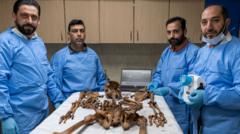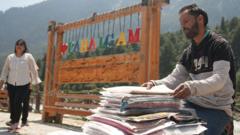Al-Ula, Saudi Arabia, is on a trajectory to become a bustling tourist destination, as the Saudi government invests in hotel construction and art projects to attract global travelers, raising concerns about its preservation.
**Al-Ula: Saudi Arabia’s Soon-to-Be Tourist Hotspot**

**Al-Ula: Saudi Arabia’s Soon-to-Be Tourist Hotspot**
As Al-Ula transforms with new developments, visitors rush to experience its wild beauty before commercialization takes over.
In the vast stretches of the Saudi Arabian desert lies Al-Ula, a remarkable landscape characterized by stunning sandstone and granite formations. This hidden gem is quickly shedding its remote status as the Kingdom of Saudi Arabia embraces tourism opportunities, a transition that gained momentum about six years ago. Initially, the desert beauty could only be explored by a limited number of pilgrims and locals, but as the walls of exclusivity break down, Al-Ula emerges as a looming attraction—both enticing and alarming.
From the moment I applied for my online visa, which was approved in a shocking three hours, the transformation of this area is palpable. Visitors are racing to uncover Al-Ula’s treasures before commercial endeavors alter its pristine charm altogether. The sandstone cliffs and the ancient tombs carved by the Nabateans whisper tales of the past, situated at the edge of the once-revered empire that created Petra, located some 550 kilometers north in Jordan.
However, with the rapid growth of tourism comes an inevitable risk; Al-Ula may soon mirror Petra’s bustling atmosphere, filled with crowds eager for the perfect social media snapshot amid sprawling hotel complexes and packed tours. Saudi Arabia is on a mission to reshape its global perception, with hopes to distance itself from its past characterized by human rights issues, stringent laws, and ongoing criticisms regarding its treatment of women.
Despite the tourism surge, some restrictions still loom—alcohol remains banned, though changing tides have prompted talks about loosening such laws as Saudi Arabia gears up for the 2034 World Cup and the ambitious Vision 2030 plan aimed at diversifying its economy.
While Al-Ula remains a captivating and relatively untouched beacon of natural and historical significance, Saudi Arabia's other key cities such as Riyadh and Jeddah have already undergone substantial transformations into flourishing urban centers, providing a glimpse into the country’s rapid modernization. Women, too, have gained significant rights over the past decade, with the ability to drive and travel freely without male supervision, illustrating the sweeping cultural changes taking place within the kingdom.
As Al-Ula is poised on the brink of a transformation that could eclipse its current unspoiled nature, travelers today have a unique window of opportunity to experience its raw beauty before the inevitable surge of tourists alters its landscape forever.
From the moment I applied for my online visa, which was approved in a shocking three hours, the transformation of this area is palpable. Visitors are racing to uncover Al-Ula’s treasures before commercial endeavors alter its pristine charm altogether. The sandstone cliffs and the ancient tombs carved by the Nabateans whisper tales of the past, situated at the edge of the once-revered empire that created Petra, located some 550 kilometers north in Jordan.
However, with the rapid growth of tourism comes an inevitable risk; Al-Ula may soon mirror Petra’s bustling atmosphere, filled with crowds eager for the perfect social media snapshot amid sprawling hotel complexes and packed tours. Saudi Arabia is on a mission to reshape its global perception, with hopes to distance itself from its past characterized by human rights issues, stringent laws, and ongoing criticisms regarding its treatment of women.
Despite the tourism surge, some restrictions still loom—alcohol remains banned, though changing tides have prompted talks about loosening such laws as Saudi Arabia gears up for the 2034 World Cup and the ambitious Vision 2030 plan aimed at diversifying its economy.
While Al-Ula remains a captivating and relatively untouched beacon of natural and historical significance, Saudi Arabia's other key cities such as Riyadh and Jeddah have already undergone substantial transformations into flourishing urban centers, providing a glimpse into the country’s rapid modernization. Women, too, have gained significant rights over the past decade, with the ability to drive and travel freely without male supervision, illustrating the sweeping cultural changes taking place within the kingdom.
As Al-Ula is poised on the brink of a transformation that could eclipse its current unspoiled nature, travelers today have a unique window of opportunity to experience its raw beauty before the inevitable surge of tourists alters its landscape forever.





















